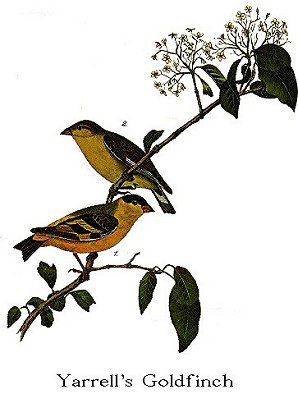
| Family XV. FRINGILLINAE. FINCHES. GENUS VIII. CARDUELIS, Cuv. GOLDFINCH. |
Next >> |

Family |
YARRELL'S GOLDFINCH. [Lesser Goldfinch (see also Arkansaw Goldfinch).] |
| Genus | CARDUELIS YARRELLII, Aud. [Carduelis psaltria.] |
I am indebted to my friend WILLIAM SWAINSON, Esq., the well-known
naturalist, for skins of a pair of this pretty little bird, from which I made
the drawing of the Male and Female represented in the Plate. As the
species is found in Upper California, it may be considered as forming part of
our Fauna.
Upper California.
MEXICAN GOLDFINCH, Fringilla Mexicana, Aud. Orn. Biog., vol. v. p. 282.
Adult Male.
Bill shorter than the head, conical, compressed toward the end, very stout,
with the tip acute; upper mandible with the dorsal line declinate and very
slightly convex, the edge rather distinct, the sides rounded, the edges sharp,
declinate at the base; lower mandible with the angle short and wide, the dorsal
line almost straight, being very slightly concave, the sides convex, the edges
inflected, the tip acute. Nostrils basal, round, concealed by the feathers.
Head large, broadly ovate; neck short. Feet rather short; tarsus short,
compressed, with seven anterior scutella, and two lateral plates meeting behind
so as to form a very sharp edge; toes rather large, the first stouter, the
lateral nearly equal; claws rather long, moderately arched, much compressed,
laterally grooved, very acute.
Plumage very soft and blended; short stiffish feathers at the base of the
bill. Wings rather long, little concave; the second, third, and fourth
primaries cut out toward the end; the second longest, the first half a twelfth
shorter, the third scarcely a quarter of a twelfth shorter than the second, and
exceeding the fourth by a twelfth; some of the secondaries slightly emarginate.
Tail rather short, emarginate, the feathers obliquely and narrowly rounded.
Bill flesh-coloured, somewhat dusky above. Feet and claws yellowish-brown.
The upper part of the head is deep black; the back and scapulars
yellowish-green, the hind neck and rump greenish-yellow; the wings and tail
brownish-black, the former when extended crossed by two bands, one
greenish-yellow, tipping the first row of small coverts; the other bright yellow
and broad, on the base of the primary and secondary quills; the tail also yellow
in its basal half. The lower parts are bright yellow.
Length to end of tail 4 2/12 inches; bill along the ridge (4 1/2)/12; wing
from flexure 2 6/12; tail 1 (7 1/2)/12; tarsus 6/12; hind toe (3 1/2)/12, its
claw 3/12; middle toe (4 1/2)/12, claw 2/12.
Female.
The female, which is smaller, has no black on the head, that part, with the
hind neck, back, rump, scapulars and smaller wing-coverts being light
yellowish-green, tinged with grey; the wings and tail wood-brown; the coverts
tipped with dull yellowish-green; the bases of the primary quills white; the
quills edged with greyish-white; the base of the tail, the two middle feathers
excepted, white on the inner webs to within half an inch of the end; the lower
parts are dull greenish-yellow.
Length to end of tail 4 inches; bill along the ridge 4/12; wing from
flexure 2 1/2; tail 1 3/4; tarsus 6/12.
In the brief specific character of this species given by Mr. SWAINSON, the
bird is said to be "glossy black, beneath yellow; base of the quills and lateral
tail-feathers white." The first and last of these characters, however, do not
agree with the male presented by himself, which has only the upper part of the
head, and part of the wings and tail black, the back being yellowish-green.
This species is much smaller than the Arkansaw Siskin, and is very similar in
its markings, but is of a much brighter yellow.
| Next >> |